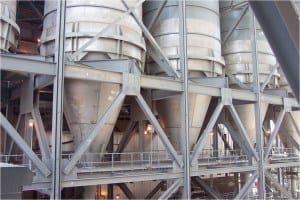Areas of Research
The Centre for Bulk Solids and Particulate Technologies is actively involved in both fundamental and applied research for a wide range of problems associated with Bulk Solids & Particulate Technology. The Centre’s main research areas comprise:
- Storage
- Flow
- Processing
- Transportation of bulk solids
At present, the following research projects funded by the Australian Research Council are undertaken:
- Analytical, numerical and testing procedures for improved design and performance of bulk solids systems
- An investigation of granular stress fields and permeability interactions in gas-solid flow
- Mechanisms of slug formation, stability and decay in pneumatic conveying
- Pneumatic conveying pipeline management system for wear minimisation
- Development of a new generation low rolling resistance conveyor belt
- Development of a high capacity steep angle belt conveying system
In addition, the following postgraduate research projects are currently in progress:
Bulk Materials Storage and Flow:
- A new approach to stress field analysis in mass flow structures
- Investigation and development of radial stress theory for granular flow in silos and stockpiles
- Validation of discrete element modelling for hopper flow
Hydraulic Conveying:
- Investigation of the pumpability of fly ash slurries
Pneumatic Conveying:
- Apparent viscosity of aerated powders
- Behaviour of aerated powders in dense phase pneumatic transport
- Behaviour of dense aerated powders in pneumatic transport and modelling of solids flow resistance
- Development of a constitutive model of energy factors in erosive wear models to predict the service life of pneumatic pipelines
- Experimental investigation and modelling of bypass systems in pneumatic conveying
- Numerical modelling of pneumatic conveying systems for particulate materials
- Stress Fields within Granular Multi-phase Systems
Dust Emission:
- Examination of the passive dust control problem during the transfer phase of belt conveying systems
- Passive Control of Dust Emissions from Belt Conveyor Transfer Points
- Passive control of dust emissions in discrete bulk materials feed situation
Belt Conveying:
- Bulk solids interactions in belt conveying
- Conveyor splice analysis
- Dynamic analysis of an enclosed, steep angle conveying system incorporating multiple drive systems
- Indentation rolling resistance
- Investigation of continuous transportation systems for ore and waste rock from deep open-pit mines
- String theory of belt weighing
Recently TBS has also completed the below multi-year contract research industry collaboration facilitated through AMIRA international:
Systematic Evaluation of Transportable Moisture Limit (TML) Measurement Methods for Iron Ore Fines Bulk Cargoes
Bulk cargo shifting of mineral ores and concentrates was understood to have led to the recorded loss of sixteen ships and one hundred and thirty three lives over the past thirty two years. In the majority of cases, this shifting was believed caused by bulk cargo instability due to excessive moisture content. The International Maritime Organisation (IMO) established procedures for safe transport of bulk commodities, including the definition of three tests for the determination of Transportable Moisture Limit (TML). In 2012, in response to the loss of the ships, the IMO warned of the probable dangers of liquefaction associated with the carriage of iron ore fines, and established a correspondence group to define a specific schedule for iron ore fines for the next revision of the International Maritime Code of Safe Practice for Solid Bulk Cargoes (IMSBC) code. Major Australian and Brazilian Iron Ore companies came together to work collaboratively on this issue, and as part of this the AMIRA project was initiated bringing together the expertise of the University of Newcastle, University of Auckland and CSIRO.
The University of Newcastle provided expertise in bulk solids handling, laboratory TML testing and modelling of sliding failure of iron ore cargoes under ship motion and estimation of the propensity of moisture to migrate through the ore cargo. The contributions from all the researcher institutions combined with the transport data from the partner companies led to the validation and ultimate acceptance from the IMO of a new iron ore fines TML test method. This provided a repeatable and reproducible bench scale test method where a safe moisture limit can be determined to ensure cargo stability is maintained in adverse sea states











